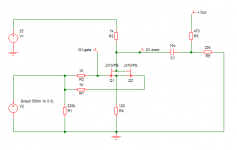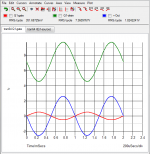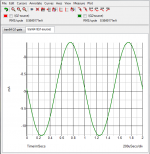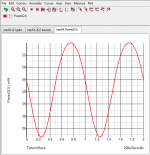Do you happen to have the exact schematic you used?
This schematic
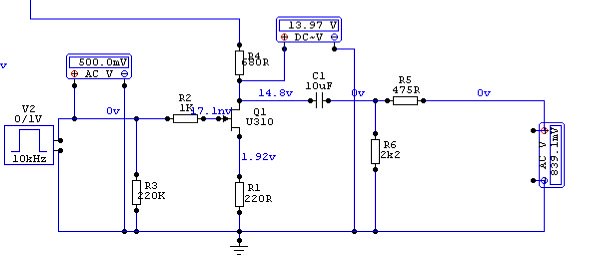
I tried the jboz with the 310 with bad results, more distortion and an hf oscillation (Maybe I did some things wrong)
there is sort of 310 BOZ sch posted by Juma
it works flawlesly
search
This schematic

I played around with your ideas and came up with some valuable modifications:
(there's a very nice power curve and decent gain)
Attachments
Nice, can you simulate this with a JFet-current source in the source.
Thanks
Joao
Of course! 🙂
there is sort of 310 BOZ sch posted by Juma
it works flawlesly
search
Yes, was based on the Juma schematic, but not luck here. I did the J310 preamp and have worse numbers than the K170 (The only good thing is much lower gain) (I made two preamps at the same time for do the mods and comparisons).
I played around with your ideas and came up with some valuable modifications:
(there's a very nice power curve and decent gain)
Thanks 🙂, I'll try it
This might have been asked before but what is the purpose of the 475 resistor in series with the output capacitor?
This schematic

R5 and R6 have wrong values in that sch.
R6 overloads the JFET (you can keep it but make it 100k) and R5 needlessly increases the output impedance (22R is enough to isolate cable capacitance).
Last edited:
R5 and R6 have wrong values in that sch.
R6 overloads the JFET (you can keep it but make it 100k) and R5 needlessly increases the output impedance (22R is enough to isolate cable capacitance).
R5 and R6 are from the original schematic.
But when I did the 310's mod, I tried R6 with 50K, and 100K as well (I didn't change the R5 value).
Does it work with 12V power supply?
If you have a adequate Idss on the K170's, yes
OK I can make it 16V optimal for 2SK170 as NP intended.
Why go with U310?
In this post, you can get a idea about the relationship between Idss and V for the K170.
The U310 have less gain than the K170
For the original circuit, why are there two 2.2k load resistors one to Vcc and other to ground after the output C?
Can we just use say 1.1k resistor (1k should be close enough) as drain resistor connected to Vcc?
This probably means Vcc must be adjusted for sweet spot.
Can we just use say 1.1k resistor (1k should be close enough) as drain resistor connected to Vcc?
This probably means Vcc must be adjusted for sweet spot.
BOZ-J - A listening Impression - Replaced Attenuator
For sometime now I was using a P.E.C. pot in the BOZ-J.
Althought it the P.E.C. pot sounded good, it was noisy/scratchy from the minute it was installed. It never cleared up and rotating the pot back and forth to clear the scratchiness was usless.
It was replaced with a parallel 24-stepped attenuator from 8Audio.com.
It uses 1% metal film resistors of an unknown brand. They look like standard Xircon color coded 1% metal film resistors. I suspose an email to the pot manufacture would reveal the brand of resistor. The attenuator is well built and small enough to fit inside a 1.5" high case with some clearance for small, flexible wiring for the in, out, ground connections.
From a cold start of all equipment, there was an improvement. After warm up, it was evident that stepped attenuators are the real thing. To describe the sound: everything was more fluid, had bit more resolution and had a bit deeper soundstage and it made most music more involving. The layers of instruments was better defined. I also noticed a bit wider sound stage beyond the speaker's outer edge.
For a small, simple, easy to build pre-amp, it continues to deliver better sound when upgrading components. It's hard to believe.
Vince
For sometime now I was using a P.E.C. pot in the BOZ-J.
Althought it the P.E.C. pot sounded good, it was noisy/scratchy from the minute it was installed. It never cleared up and rotating the pot back and forth to clear the scratchiness was usless.
It was replaced with a parallel 24-stepped attenuator from 8Audio.com.
It uses 1% metal film resistors of an unknown brand. They look like standard Xircon color coded 1% metal film resistors. I suspose an email to the pot manufacture would reveal the brand of resistor. The attenuator is well built and small enough to fit inside a 1.5" high case with some clearance for small, flexible wiring for the in, out, ground connections.
From a cold start of all equipment, there was an improvement. After warm up, it was evident that stepped attenuators are the real thing. To describe the sound: everything was more fluid, had bit more resolution and had a bit deeper soundstage and it made most music more involving. The layers of instruments was better defined. I also noticed a bit wider sound stage beyond the speaker's outer edge.
For a small, simple, easy to build pre-amp, it continues to deliver better sound when upgrading components. It's hard to believe.
Vince
Last edited:
- Home
- Amplifiers
- Pass Labs
- Jfet BOZ
